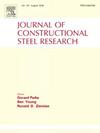Numerical analysis and restoring force model of semi-prefabricated CFDST column-steel beam joint
IF 4
2区 工程技术
Q1 CONSTRUCTION & BUILDING TECHNOLOGY
引用次数: 0
Abstract
Concrete-filled double-skin tubular (CFDST) structures demonstrate considerable potential in high-rise building applications and resilience against extreme disasters. However, traditional CFDST joint designs face challenges in engineering practice, such as high construction difficulty and complex on-site welding, which limit the widespread application of CFDST structures. This study developed a novel semi-prefabricated CFDST column-teel beam joint and conducted quasi-static tests on five joints. Subsequently, an accurate finite element model (FEM) was established and validated through comparison with the experimental results, including the failure modes, the hysteresis and skeleton curves, and the moment capacity. Building on the high accuracy of the model, 21 finite element simulations were conducted to analyze the effects of eleven parameters on the performance of the joint. The results revealed that increasing the thickness of the outer square steel tube by 4 mm and extending the ring plate length by 80 mm enhanced energy dissipation by 14.6 % and 95.3 %, respectively. Replacing a solid-core CFDST column with a hollow-core design not only reduced structural weight but also facilitated the inner circular steel tube to carry more load as the outer square tube reached its ultimate strength. Additionally, the joint exhibited excellent seismic performance even under a high axial compression ratio of 0.45. Finally, a trilinear skeleton curve model and hysteretic rules were established, and a simplified restoring force model was proposed. This model demonstrates high evaluation accuracy and can serve as a reference for the elasto-plastic seismic response analysis of such structures.
半预制CFDST柱-钢梁节点数值分析及恢复力模型
混凝土填充双层管(CFDST)结构在高层建筑应用和抵御极端灾害方面显示出相当大的潜力。然而,传统的CFDST节点设计在工程实践中面临施工难度高、现场焊接复杂等挑战,限制了CFDST结构的广泛应用。研究了一种新型的半预制CFDST柱-钢梁节点,并对5个节点进行了拟静力试验。建立了精确的有限元模型,并与试验结果进行了对比验证,包括破坏模式、迟滞曲线和骨架曲线以及弯矩承载力。在模型精度较高的基础上,进行了21次有限元仿真,分析了11个参数对接头性能的影响。结果表明,外方钢管厚度增加4 mm,环板长度增加80 mm,能分别提高14.6%和95.3%的能量消耗。将实芯CFDST柱改为空心柱,不仅减轻了结构重量,而且在外方管达到极限强度的情况下,有利于内圆钢管承受更大的载荷。此外,即使在0.45的高轴压比下,节点也表现出良好的抗震性能。最后,建立了三线性骨架曲线模型和滞回规律,提出了一种简化的恢复力模型。该模型具有较高的评价精度,可为此类结构的弹塑性地震反应分析提供参考。
本文章由计算机程序翻译,如有差异,请以英文原文为准。
求助全文
约1分钟内获得全文
求助全文
来源期刊

Journal of Constructional Steel Research
工程技术-工程:土木
CiteScore
7.90
自引率
19.50%
发文量
550
审稿时长
46 days
期刊介绍:
The Journal of Constructional Steel Research provides an international forum for the presentation and discussion of the latest developments in structural steel research and their applications. It is aimed not only at researchers but also at those likely to be most affected by research results, i.e. designers and fabricators. Original papers of a high standard dealing with all aspects of steel research including theoretical and experimental research on elements, assemblages, connection and material properties are considered for publication.
 求助内容:
求助内容: 应助结果提醒方式:
应助结果提醒方式:


